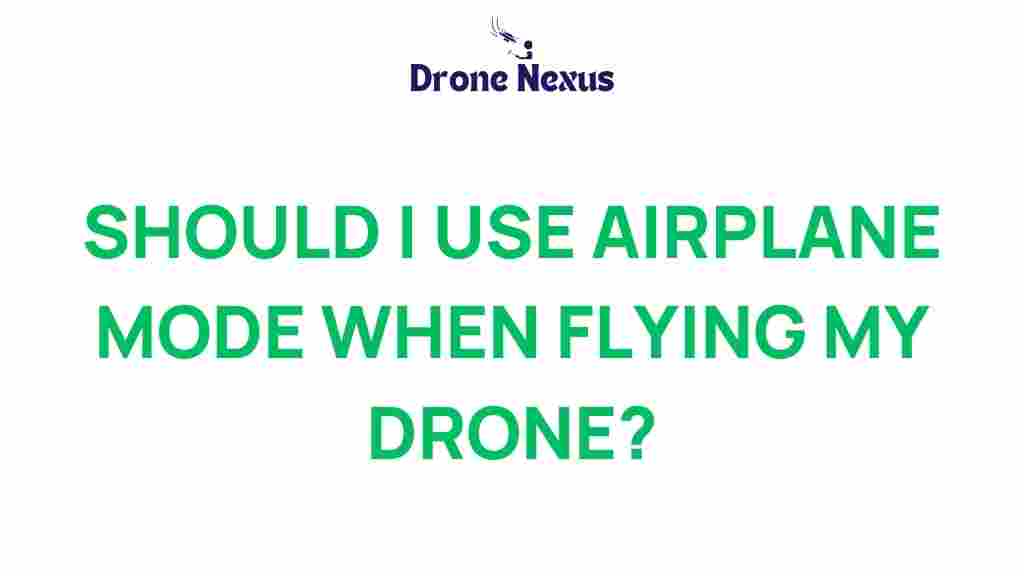Should You Activate Airplane Mode While Flying Your Drone?
Flying a drone can be an exhilarating experience, offering stunning aerial views and a unique perspective of the world around you. However, as with any technology, there are certain protocols and best practices to follow, particularly regarding airspace regulations and device settings. One common question among drone enthusiasts is whether or not to activate airplane mode while flying their drone. In this article, we will explore the concept of airplane mode, its implications for drone operation, and provide guidance on how to ensure a safe and enjoyable flying experience.
What is Airplane Mode?
Airplane mode is a setting available on most mobile devices that disables all wireless communication functions, including cellular data, Wi-Fi, and Bluetooth. This feature is primarily designed for use during flights on commercial airplanes, where electronic devices must be in a non-communicative state to minimize interference with navigation and communication systems.
When activated, airplane mode can help conserve battery life and reduce distractions, making it an appealing option for drone pilots who want to ensure a smooth flying experience. However, the implications of activating airplane mode while operating a drone can vary based on the type of drone, its control system, and the specific flying conditions.
Understanding the Implications of Airplane Mode on Drone Operations
When considering whether to activate airplane mode while flying a drone, it’s essential to understand how this setting interacts with your drone’s functionalities. Here are some key points to consider:
- Remote Control Communication: Most drones rely on a stable connection between the controller and the drone for real-time communication. Activating airplane mode can disrupt this connection, preventing you from controlling the drone effectively.
- GPS Functionality: Many drones use GPS for navigation and positioning. If your smartphone or tablet loses its network connection due to airplane mode, it may also lose access to GPS data, affecting your drone’s ability to stay on course.
- Firmware Updates: Some drones require a connection to the internet for firmware updates or additional features. Activating airplane mode can hinder these updates, leaving your drone vulnerable to bugs or performance issues.
When to Use Airplane Mode
Despite the potential drawbacks, there are specific scenarios where activating airplane mode may be beneficial:
- Battery Conservation: If you’re flying in an area with poor cellular reception, enabling airplane mode can help conserve battery life on your device, allowing you to focus on your drone’s operation.
- Reducing Distractions: Airplane mode can help minimize notifications and calls, allowing you to concentrate fully on your drone flight.
Step-by-Step Process: How to Properly Prepare for Drone Flight
To ensure a successful and safe flight, follow these steps before taking to the skies:
1. Check Local Regulations
Before flying your drone, familiarize yourself with local laws and regulations regarding drone usage. Some areas have restrictions on where you can fly, altitude limits, and requirements for notifications or permits.
2. Prepare Your Drone and Device
Ensure both your drone and controlling device are fully charged and in good working condition. Check for any firmware updates that need to be installed before your flight.
3. Decide on Airplane Mode
Based on your understanding of airplane mode and its effects, decide whether to activate it. If you choose to enable it, ensure that you have already downloaded necessary maps or data for your flight.
4. Perform a Pre-Flight Check
Conduct a thorough pre-flight check of your drone, including:
- Inspecting the drone for any visible damage
- Calibrating the compass and GPS
- Verifying battery levels
- Testing the remote control
5. Take Off
Once your pre-flight checks are complete and you’re satisfied with your settings (including airplane mode decisions), take off in a safe and open area, away from obstacles and people.
Troubleshooting Tips for Drone Flight
Even with thorough preparation, issues can arise during a drone flight. Here are some troubleshooting tips to address common problems:
Issue: Connectivity Loss
If you experience a loss of connectivity between your drone and the controller, consider the following:
- Check your device’s airplane mode setting and disable it if necessary.
- Ensure that you are within the operational range of your drone.
- Restart both the drone and the remote control to re-establish the connection.
Issue: GPS Signal Loss
If your drone is struggling to lock onto a GPS signal:
- Move to an open area away from tall buildings or trees that may be obstructing the signal.
- Ensure that your smartphone or tablet has not enabled airplane mode, affecting GPS functionality.
- Wait for a few minutes for the drone to recalibrate and pick up a stronger signal.
Issue: Low Battery Warning
If you receive a low battery warning during your flight:
- Immediately prepare to land your drone in a safe location.
- Monitor the battery level closely and avoid aggressive maneuvers to conserve battery life.
Conclusion
In summary, the decision to activate airplane mode while flying your drone should be based on an understanding of your specific device, the drone’s operation, and the environment in which you are flying. While airplane mode can offer certain benefits, such as battery conservation and reduced distractions, it is crucial to consider the potential drawbacks, particularly regarding connectivity and GPS functionality. Always prioritize safety and compliance with local regulations and be ready to troubleshoot any issues that arise during your flight.
For more detailed information on drone regulations and best practices, check out this resource. Additionally, if you’re looking to enhance your flying skills, consider joining a local drone club or community where you can share experiences and learn from other enthusiasts.
This article is in the category Safety and created by DroneNexus Team
